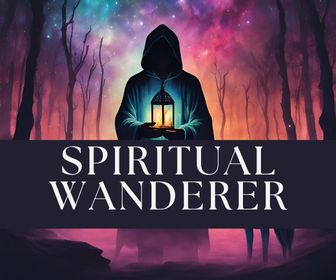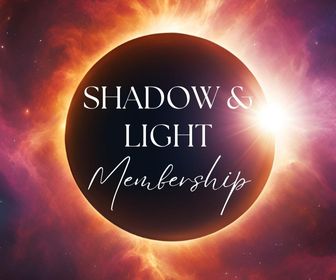When you hear the word “ritual” what do you think about?
You might immediately associate the term with pentagrams, circles of candles, ominous chanting and cloaked figures. You might picture occult symbols, darkly lit rooms, voodoo dolls or any number of other stereotypical images linked with the word.
The word “ritual” is almost always assumed to have religious connotations – after all, almost every culture since the beginning of time has incorporated rituals into their spiritual and religious ceremonies. From the ancient Egyptians, American Indians and Mayans, to the Buddhists, Christians, Jews and Muslims, rituals of every kind have been created and sustained for almost every purpose imaginable.

Spiritual Wanderer Course:
⭐️⭐️⭐️⭐️⭐ "I started the Spiritual Wanderers Course a short while ago and for the first time in twelve years I have started to experience love, acceptance and compassion for myself and within myself. Thank you so much." – Vivienne S.
So it might come as a surprise to you to discover that rituals don’t have to be esoteric, rituals don’t have to be religious and rituals don’t have to be spiritual. In other words, you don’t have to belong to any tradition to practice them, you don’t have to be religious or spiritual to practice them, and you don’t have to make them “occult” or “new age” to practice them.
What is a Ritual and How Can You Benefit from One?
The rituals I speak of in this article are free for any person of any age, gender, religion, non-religion or culture to practice. The beautiful thing about rituals is that they are a habitual set of actions that are imbued with deep and personally significant meaning. Rituals, when practiced consistently and introspectively, can have an immensely beneficial impact on your life.
But the truth – something vital to remember – is that rituals in and of themselves have no power of their own. Think of them like you would a cup: a cup is a vessel for life-nourishing water, but when empty it doesn’t serve us much purpose. The same can be said for rituals; when over-used, they can become empty, lifeless and pointless. Unfortunately, many people in our world forget this and waste large portions of their time worshiping the “cup” rather than honoring the water within.
This is why I recommend setting an “Expiry Date” for your rituals. While some rituals will last you a year or more, others will last you a month, a week, a day, or even a minute.
That being said, here are some benefits of having a ritual:
• Rituals help you to “banish” bad habits.
• Rituals help you to heal.
• Rituals help you to create closure.
• Rituals help you to “invoke” the healing powers of transformation.
• Rituals help you to remain focused and goal orientated.
• Rituals help you to develop self-discipline.
The power of our rituals is directly dependent on the power of our will and intention. In a sense, rituals are like symbolic commitments we make to ourselves to grow, to strengthen, to heal and to surrender.

Shadow & Light Membership:
⭐️⭐️⭐️⭐️⭐ "Straight from the very first weekly email, this has been mind-blowingly powerful, the synchronicity and the on-vibe contents resonate uncannily with my soul’s current challenges." – Marie
4 Types of Rituals
You might benefit from custom-creating a ritual of your own, or you might find it easier to use a ritual that has already been “tried and tested.” Whatever the case, I hope the rituals below inspire you. When I first started incorporating morning rituals into my process of inner healing and transformation, I experimented with both pre-established kinds, and custom-made creations. Below you will find a sample mixture of both.
1. Light a Candle and Blow it Out
Blowing out the flame of a candle has always symbolized “death” or an “ending” of something to me. I like to use this ritual when I wish something to end or cease in my life, for example, my core wound of guilt. By no means do I rely on this ritual to heal myself, but I do use it to facilitate my healing and to bridge a gap between my conscious and unconscious mind.
To complete this ritual simply set aside a time and a quiet place every day (for however long necessary), light a tea light or a small candle, hold it in your hands, stare into the flame and hold your intention in mind. For instance, your intention might be, “My anger is slowly fading away like the flame of this candle. I am finding forgiveness again.” Then, blow the flame out.
2. Anoint Yourself/Bathe
Anointing has been viewed as something distinctly Catholic, but it doesn’t have to be. I associate anointing with purification and renewal, so it is particularly significant in periods of life that call for personal “rebirth.” For example, you might be particularly stressed out from your new job and you might desire to rid yourself of the accumulation of toxic energy you have gathered throughout the day. Anointing yourself – particularly with essential oils – and bathing, is the perfect symbolic ritual to renew yourself.
Chamomile, Rose, Sage and Lavender are just some of the many essential oils that, when diluted, provide a number of mind-body health benefits perfect for this type of ritual. I personally like the practical and sacred benefits of Tea Tree Oil and its ability to awaken and restore the physical and emotional body.
Simply dilute some essential oil in a small bowl of warm water. You can choose to dip your fingers in the oil and anoint each energy center of your body (head, throat, chest, stomach, etc.), or you can choose to gently pour the water over your head while you are in the shower, visualizing the tension in your body flowing away.
3. Let the Wind Carry Away the Feather
The wind has always been something of a mysterious force to me: it is unseen, but powerful. In many ways, wind is symbolic of life itself. Feathers, on the other hand, are very earthly, but also fly easily away with the wind.
The wind and feather ritual is symbolic of acceptance and surrender, and is particularly useful for periods of your life where you feel emotionally burdened. The reality is that we can’t always “change” everything to our liking in our lives, and it is our resistance to what we can’t change that causes us pain.
You could use a feather, leaf or even dandelion for this ritual. In a wide expansive place (preferably outdoors), hold the delicate object in your hand, reflecting deeply on your problems. Then, when you are ready to release the feather, leaf or dandelion (and with it your resistance) blow away the item from your hand, or wait for a gust of wind to carry it off. Watch as it floats away, and with it, your angst. Every problem, strife and pain drifts away eventually.
4. Burning Your Worries Away
Cremating symbolizes finality: there is no going back! This final ritual is a particularly powerful one as it literally reduces whatever thought, feeling, intention, desire or issue you have to dust.
Would you like to save this?
Your information will never be shared.
This ritual starts with a simple piece of paper. On a small piece of paper, write down whatever problem you have experienced or are experiencing in the present. For instance, you might write, “Self-hatred,” “My jealousy of _______,” “How I don’t stand up for myself,” and so forth. Keep in mind that some emotions and experiences are actually beneficial and useful to us in unexpected (and often harsh) ways, like grief and longing. This ritual will only work with self-destructive fears, desires and intentions, so be mindful.
After you have written something down on your piece of paper, find a safe place to burn it with matches or a cigarette lighter. You might choose a place outdoors, or a safe room indoors to complete the ritual. After you have found an appropriate place and method of putting out the flames (should they get out of control), sit or stand in silence for a few minutes. Reflect on what you have written on the piece of paper and how it impacts your life. Once you are ready to truly let these feelings go, put the flame to the piece of paper and watch it burn to ashes.
You might also like to say a small prayer or a few words such as “Let it be,” “I am ready to move on,” or “I embrace the end.”
***
Remember that these rituals can be repeated as little or as much as you like. Not only do they help us to find acceptance, strength and resolve, but they also help to send a very powerful message to the unconscious mind.
Which of these rituals appeal to you? If you have any of your own types of rituals to recommend, please share below in the comments.
Whenever you feel the call, there are 3 ways I can help you:
1. The Spiritual Wanderer Course: Need "big picture" direction, clarity, and focus? Our Spiritual Wanderer course is a crystallization of 10+ years of inner work, and it can help you find your deeper path and purpose in life as a spiritual wanderer. You get 3+ hours of audio-visual content, workbooks, meditations, a premium test, and more!.
2. Shadow & Light Membership: Want weekly intuitive guidance to support you on your awakening path? This affordable membership can help you to befriend your dark side, rediscover more self-love, and reclaim inner wholeness.
3. Spiritual Awakening Bundle: Looking for a collection of all our essential transformative resources? You get five enlightening ebooks, seven in-depth journals, plus two empowering bonuses to help you soul search, heal, and awaken.






Yes, rituals don’t have to be religious or spiritual. If anything, a ritual is just a routine, but often with a special emotional meaning to you. For example, if you want to look up classic secular rituals, you can look up “morning rituals,” or the less well known but still popular, “evening rituals,” for some ideas online. You can look up the rituals of famous role models like, “Daily rituals of famous artists,” or “Daily rituals of famous geniuses.” You can look up specific rituals on deeper beliefs, such as “Mindfulness rituals,” “Grief rituals,” and “Spiritual rituals.” You can look to the past for inspiration, by looking up “Ancient rituals,” “Cultural rituals around the world,” or “Traditional rituals around the world.” You can google rituals for just practical things, such as “Daily exercise rituals,” “Rituals for stress,” “Relationship rituals,” or “Family rituals.” There’s “Rituals for writing,” “Rituals for creativity,” and “Journaling rituals,” if you want a more creative side. There can be “rituals for money,” “rituals for good luck,” or “rituals for studies/exams,” if you’re a bit on the superstitious side of things. I mean, even when looking up literal “witchcraft rituals,” or “pagan rituals,” there is actually a subset of witches that don’t really believe in God or the paranormal at all. If anything, most witches I’ve seen are like this, or maybe I spend too much time on Reddit. They just believe doing certain rituals like “Tarot rituals/Tarot spells,” “Candle magic rituals/Candle spells,” or just looking up “magick rituals/magick spells,” in general not because they believe it’s literal magic, but because they feel like these rituals just increase their confidence, and so indirectly help what they want come true. You know, it’s like how in sports, some people just carry a good luck charm, not because it necessarily works in of itself, but it helps you believe in yourself, which then increases the chances of winning. You know, a lot of people in “occult spaces,” are the same way. They don’t really believe it. They just think it helps them change internally to go after their goals more, hahaha. I am inclined to agree. Rituals are only meant to change your inner energy, to be more receptive to certain situations, scenarios, and opportunities around you, hahaha. Even if you research “The science of good luck,” or “The psychology of luck,” lucky people in studies are just more observant. They notice details in their environment to spot opportunities others can’t spot, and apparently, luck is just great observation skills to scientists, not literal magic, but still interesting to think about.